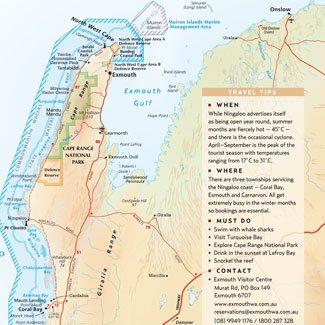Ningaloo given World Heritage status

THE NATURAL BEAUTY OF Western Australia’s Ningaloo Reef has long been considered a cut above the rest, but now that it’s been granted World Heritage status, its beauty is untouchable.
The remote Ningaloo coast, including Cape Range National Park, was inducted into the World Heritage hall of fame by The United Nations’ cultural body, UNESCO, last Friday. UNESCO recognised the site for its natural beauty, exceptional biodiversity, and significance to the continued conservation of unique marine-life including the endangered loggerhead sea turtle and the largest living fish species, the whale shark.
Ningaloo Reef is Australia’s largest fringing coral reef and is one of the longest near-shore reefs in the world. The 6000sq.km heritage-listed site supports 220 species of coral and 500 species of tropical fish and hosts an annual gathering of white whales – and that’s just under the water. On land, the site features an extensive network of underground limestone caves and complex water courses.
“This is due recognition for what is a wonderful corner of Australia, and the world. Ningaloo is one of the few remaining healthy reef systems and home to threatened species and it totally deserves to appear next to the Great Barrier Reef and the Taj Mahal,” says Darren Kindleysides, director of the Australian Marine Conservation Society.
“The area has been threatened by marina proposals and recently the oil company Shell has been looking to explore for oil and gas within 50km of the reef, but this listing puts a real responsibility on Australia to make sure the area is protected for the world, now and into the future.”

View Large Map
Ultimate protection
Unlike most nations, Australia protects World Heritage-listed sites from exploitation under national law.
Environmental campaigners are celebrating Ningaloo’s recognition as one of the world’s most important sites. World Wildlife Fund spokesman Paul Gamblin says the reef’s listing comes after more than a decade of lobbying to protect it from over-development and neglect.
“World Heritage listing was always a faraway dream,” Paul says. “Ningaloo is a place loved by the people of the region, and now more than ever before, Ningaloo will inspire the citizens of the world.”
Kakadu protection
UNESCO also gave the Koongarra area at the heart of Kakadu World Heritage status. The 1228ha site with important indigenous links – will be part of the Kakadu World Heritage Area. It was originally excluded from the park in 1979 because of its potential uranium resources.
Environment Minister Tony Burke welcomed the decision saying it will help protect Koongarra for generations to come.
“The world is acknowledging what traditional owner Jeffrey Lee has always known – that Koongarra is one of the most precious places on Earth,” he said in a statement. “This historic decision reflects the international importance of Koongarra and is testament to the untiring work of Mr Lee, who has fought for years to preserve his country for future generations.”
The listing recognises Koongarra’s proximity to Nourlangie Rock, a major Aboriginal rock art site.
“Nourlangie Rock looks out over Koongarra, so this World Heritage listing will ensure the protection and integrity of more than 20,000 years of our Indigenous history and culture,” the minister said.
There are some legal steps the government will need to finalise before Koongarra is officially included as part of Kakadu National Park. It means the area will be fully protected under law and mining prohibited, he said.
World class
World-Heritage status has protected the Wet Tropics in Queensland from logging and the Northern Territory’s Kakadu from mining projects.
Australia now boasts 18 of the 923 sites on the World Heritage register. Ningaloo and Koongarra join the Aussie roll-call of equally prestigious heritage sites including the Sydney Opera House, Fraser Island and Australia’s first three heritage-listed sites: the Willandra Lakes Region Mungo National Park, Kakadu National Park in Darwin’s Top End, and the Great Barrier Reef, inducted in 1981.
World Heritage-listed sites are considered of outstanding universal value and are selected for world-wide recognition and conservation because of their supreme cultural or natural significance.
Culturally significant properties are sites of supreme human historical value, representing masterpieces of human creative genius or testimony to past cultural traditions. Natural heritage sites are considered areas of exceptional natural beauty. These sites feature records of the Earth’s history, including the record of life, or valuable natural habitats supporting biological diversity.
152 countries currently participate in the World Heritage Convention and of the 923 World Heritage-listed properties, 712 are cultural, 183 are natural, and 28 are mixed property sites.
RELATED STORIES




